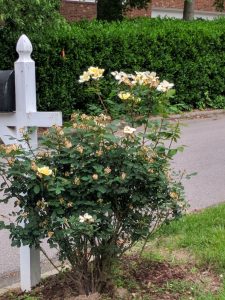This Mother’s Day I admired two rose bushes as I arrived at my parents' house. There was a yellow bush that we planted the Mother’s Day after my mother’s mom died. And a pink bush that we planted a different year, the Mother’s Day after my father’s mom died. The physical absence of these women seemed impossible to comprehend. And so on each Mother’s Day we chose something physical that could hold space for us that day, something that could provide us the visual comfort we needed. By planting each rose bush in their honor, we were committing that we would keep them in the story of our lives, when the preferred option of their presence wasn't possible. By choosing the colors, size and shape that spoke to us, by deciding where the bush would be planted, we reaffirmed that we still had the power to say what that person represented to us.
Planting those rose bushes did not suddenly make grief easier, but it did create a bond that did not exist before. Because if I didn’t create these bonds, then the only thing that I did have for certain was the lack of a physical bond that was taken by death.
In The Heart of Grief, Thomas Attig describes a powerful term of “perpetual ceremonies of separation”:
We go too far when we fix our attention permanently on the experience of loss and, in effect, make our own lives perpetual ceremonies of separation. Effective ceremonies fix our attention momentarily. In them, we pause to acknowledge what has happened and absorb the first sharp pangs of the hurt it brings into our lives. As we remember and pay tribute, we take our first halting steps in the transition from loving in presence to loving in separation.
This doesn't mean we rush to the "loving in separation" part. This process of grieving, those pangs of hurt, and what it looks like to "love in separation" later on will look different for every person and every loss. Feeling my grief, experiencing those "sharp pangs" over time allowed me to create the space in my heart to consider new ways to express “loving in separation”. I didn't want to, I wouldn't have chosen this, but it was also all that I had. In no way could either of my grandmothers' spirit or legacy be perfectly encapsulated in a rose bush. But this was one way I could create a continuing bond to these women.
Continuing Bonds is a theory introduced by Klass, Silverman, and Nickman. Continuing bonds can take many shapes and forms. It may be talking out loud to the person who died. Writing to that person. Wearing a particular jewelry piece when we want to remember or honor them. Going to certain locations. When I was 16 and grieving the death of a close family member, I often went to 7-11 and got slushies since that is something we had shared before. Bonds can take all kinds of forms.
This Mother’s Day weekend, I was fortunate to come across this blog post on relational identity in grief: I Am Still Your Daughter…You are Still my Mother.
The author challenges the reader to complete this exercise:
Regardless of where you are in your grief, I’d like to ask you to give the following exercise a try. Take few minutes to complete the sentence below:
I am still your [mother, father, son, daughter, brother sister, etc] because…
The author shares their own examples like: I still look to you for guidance. I still allow the values you taught me to serve as my compass. I still read the letters you sent me, cherishing your cursive letters scrawled across the page. I still think about you sitting at the piano every time I sit down to play the piano.
I encourage you to give it a try. Think of all the ways in which you still connect with that person. What concrete symbols do you have? What rituals do you have? What values or practices keep them connected to you? Have an example you'd like to share? Please post below.
If you are grieving a loss in which your relationship with the person was complicated or hurtful, this podcast may be helpful: When Your "Loved One" Wasn’t a Loved One.
Lastly here are some other posts on grief:
"But Someone Has It Worse"
"Moving On" After a Loss: Is it ok to be happy again?
Gratitude Versus Grief


